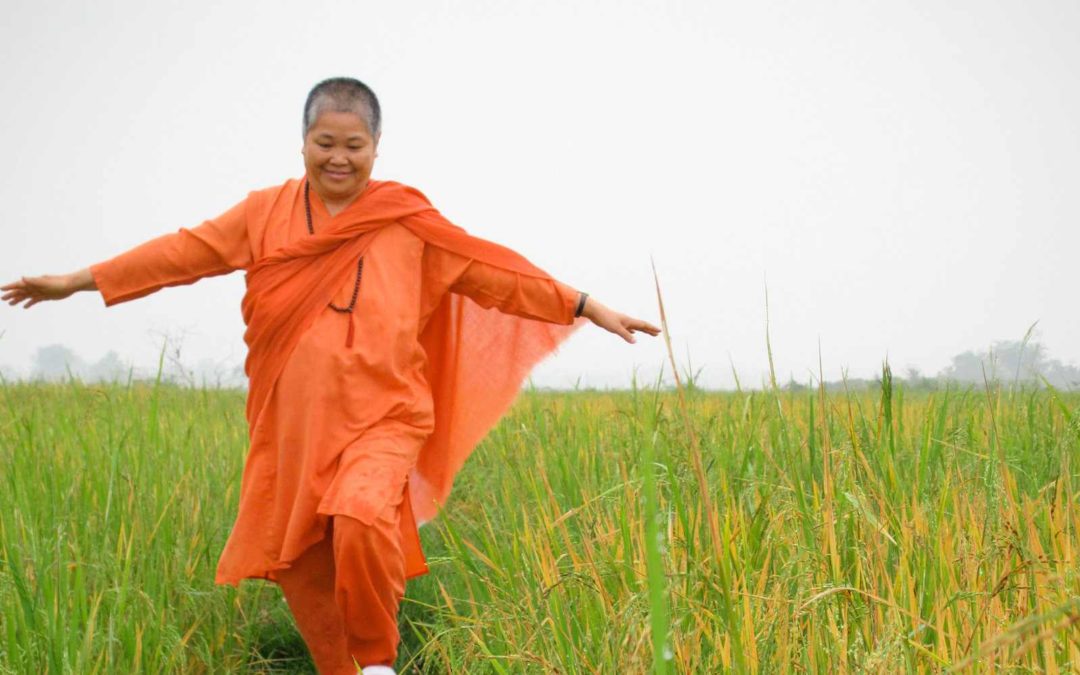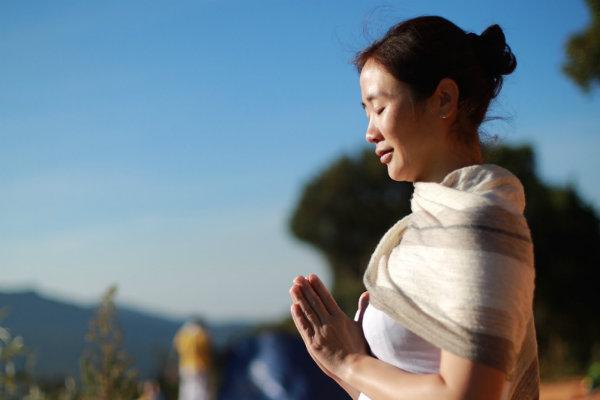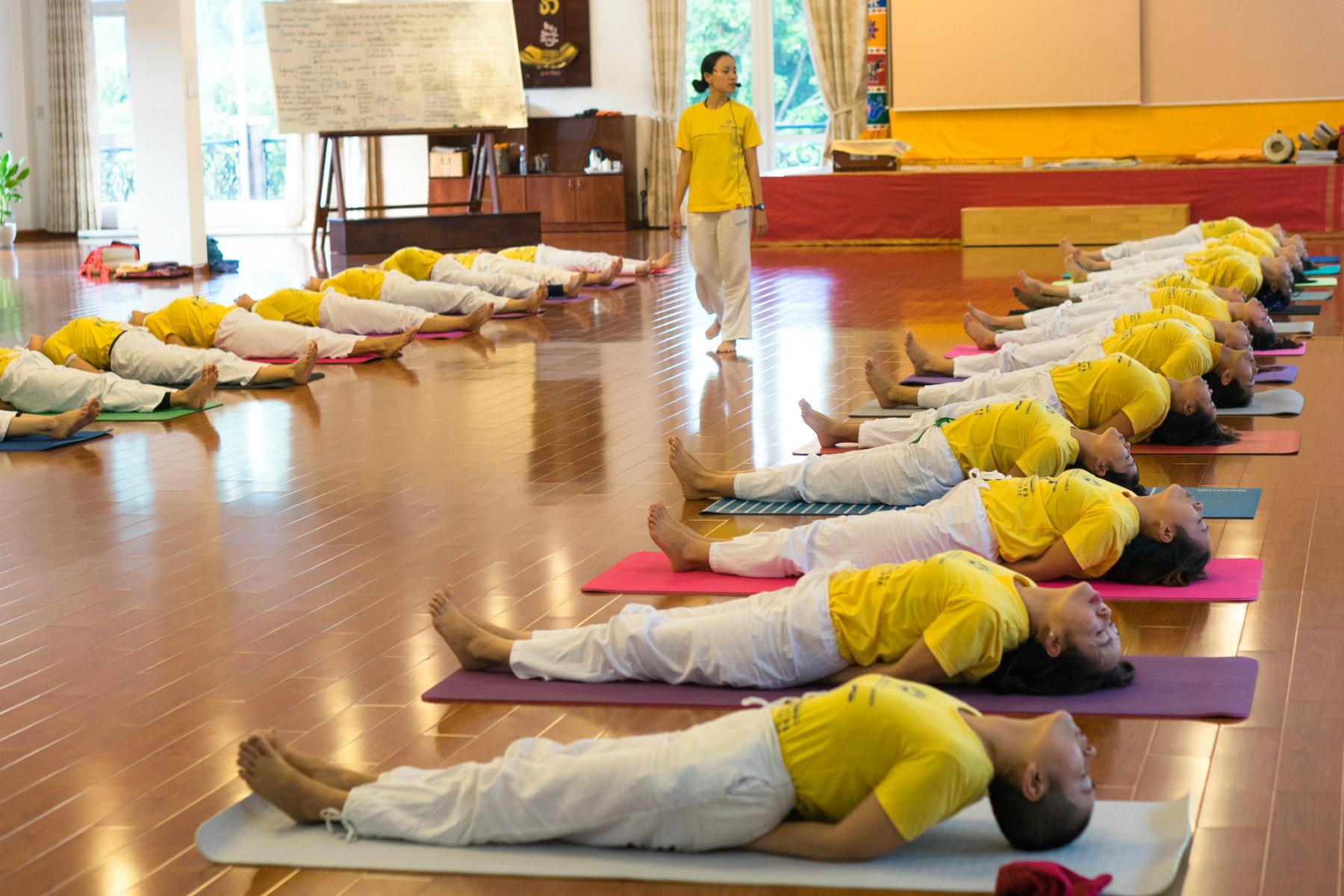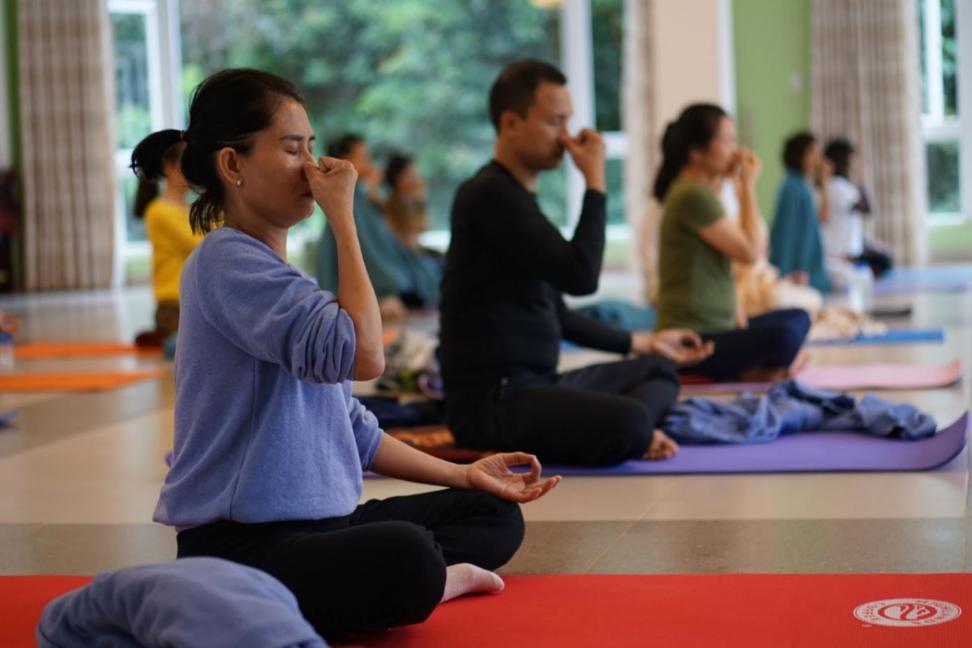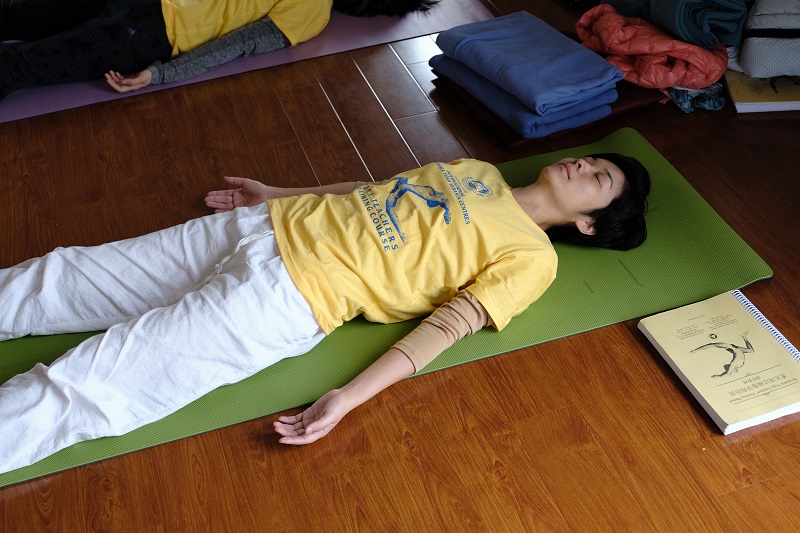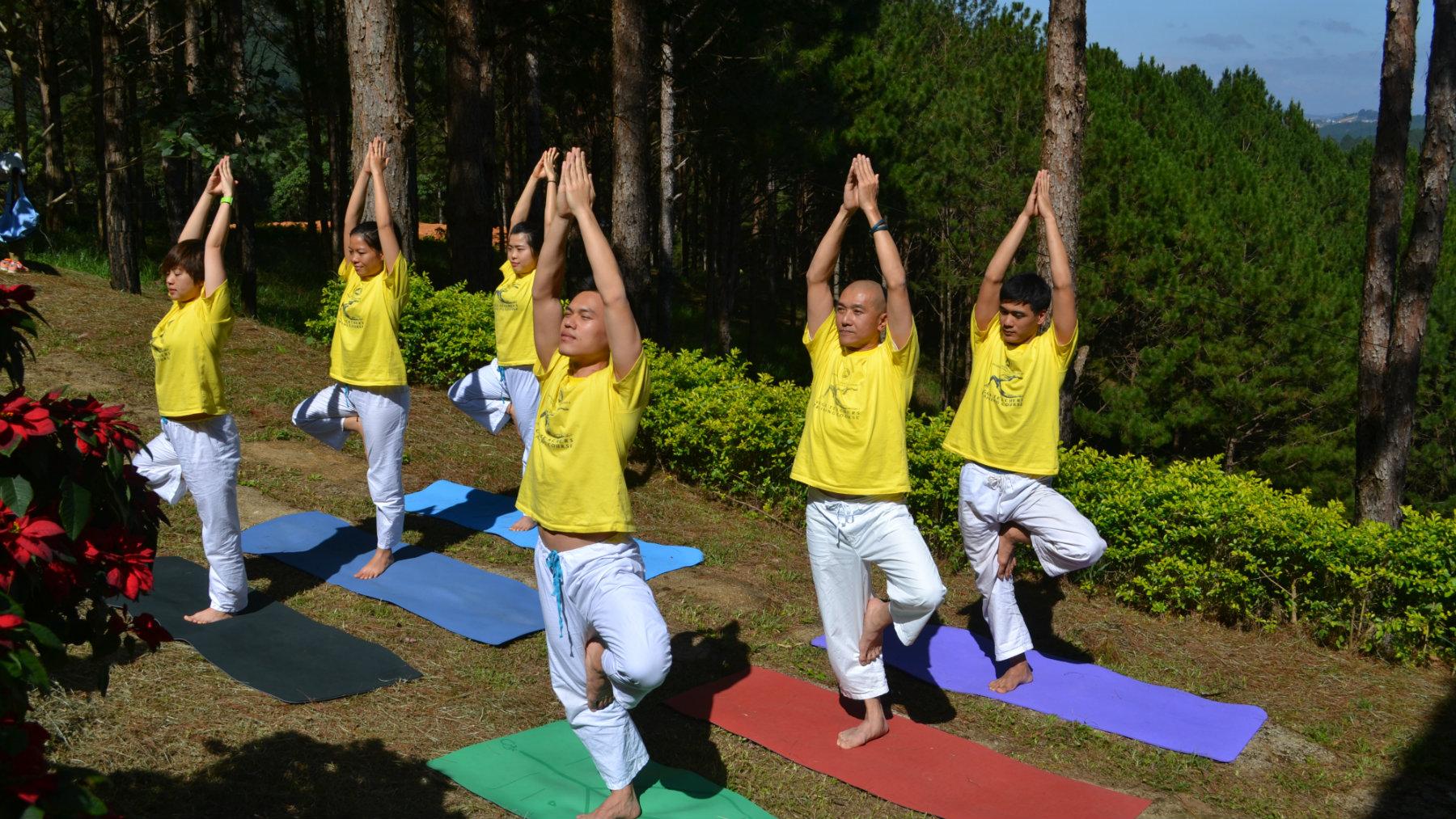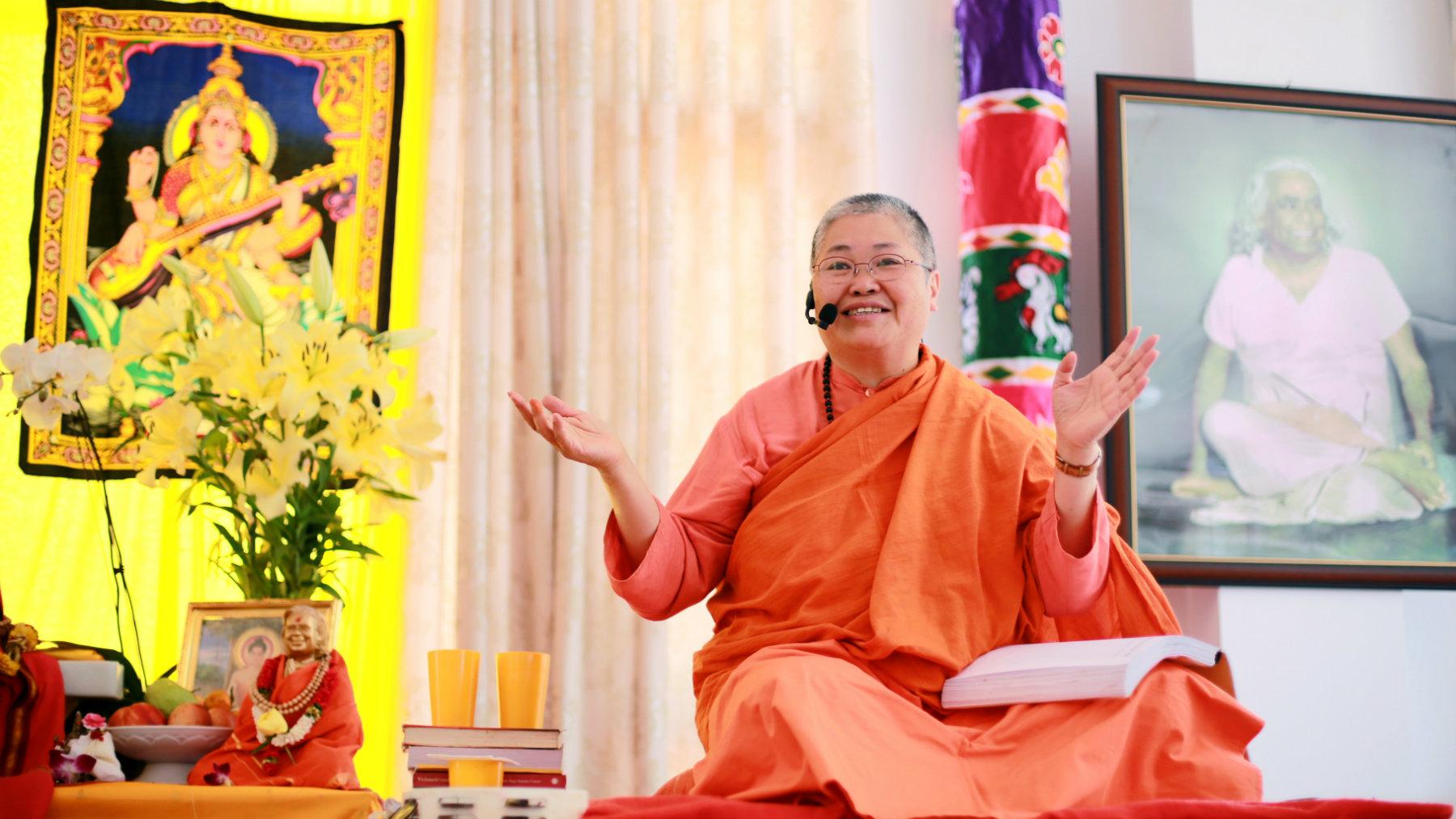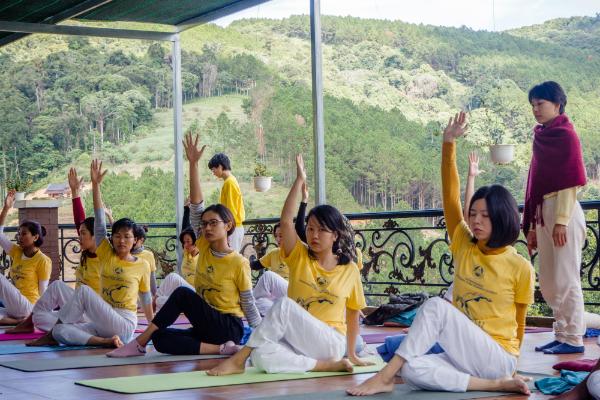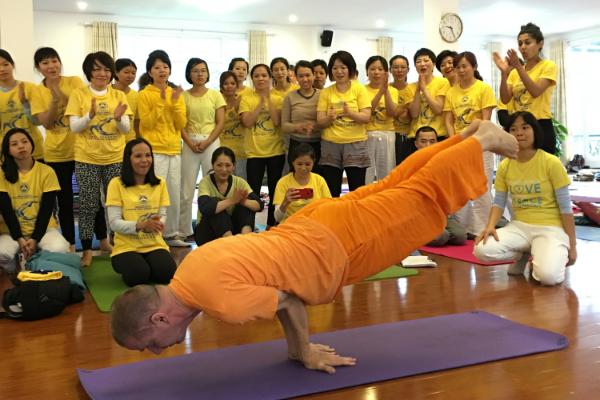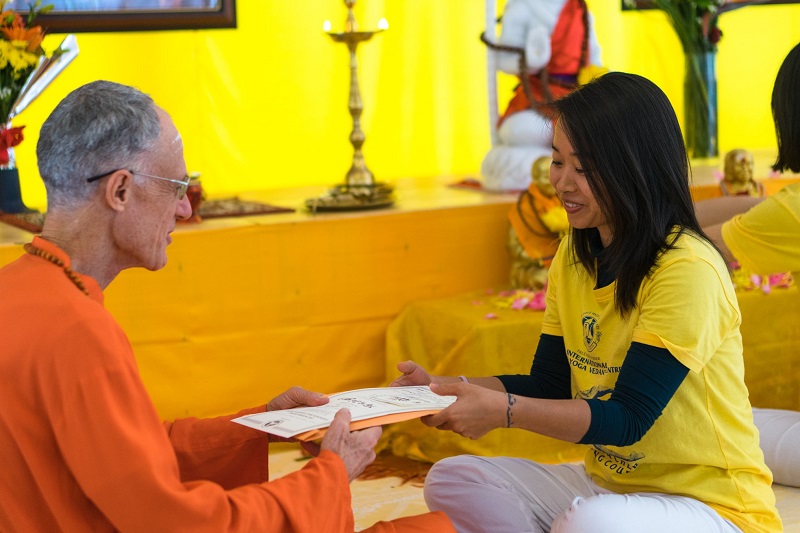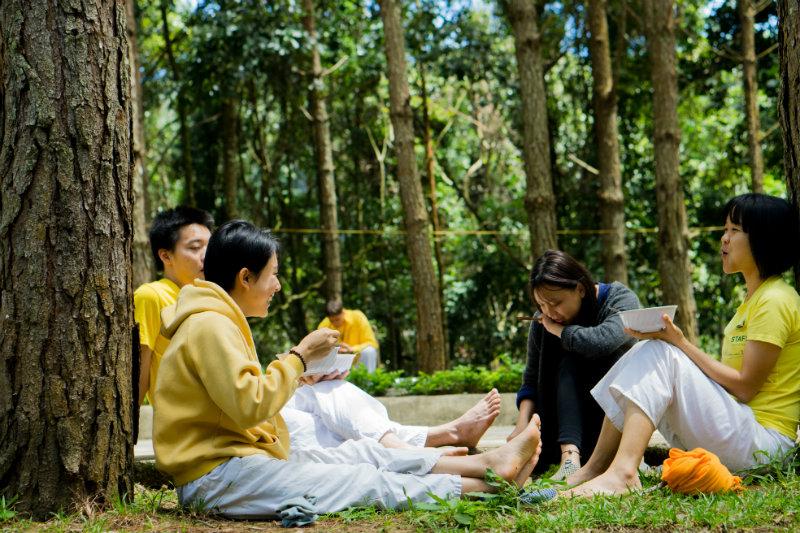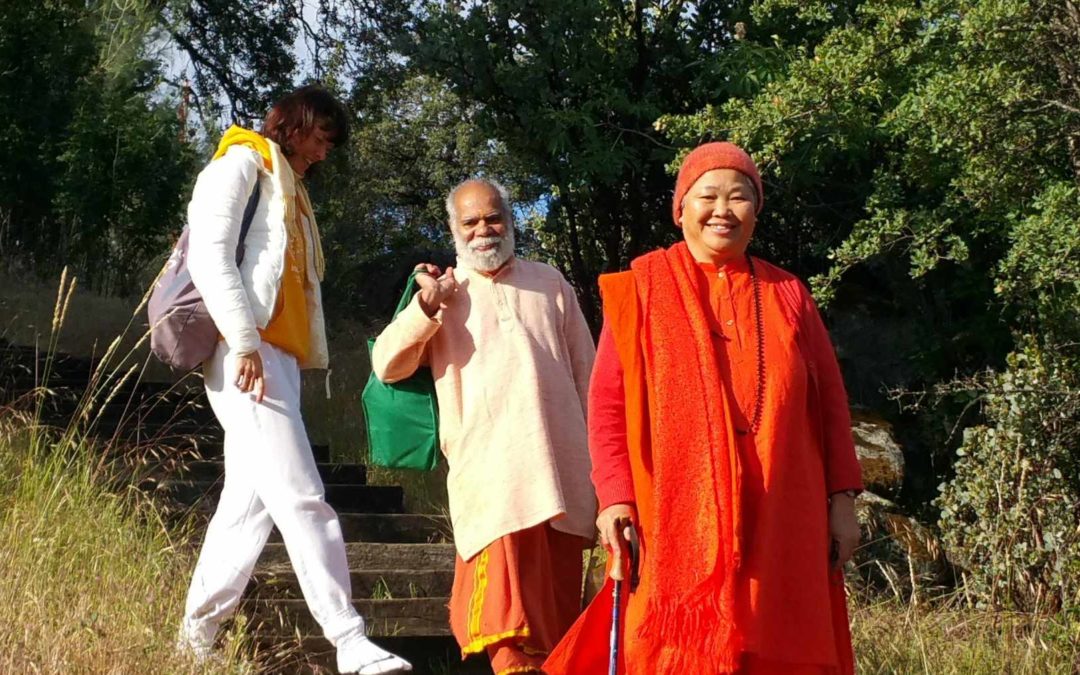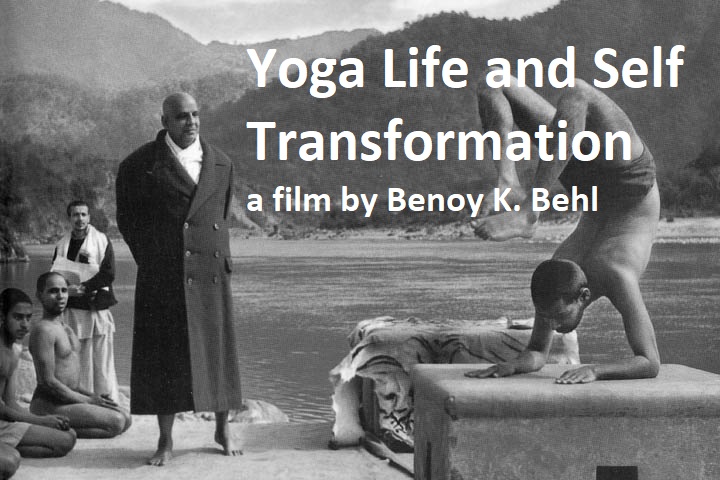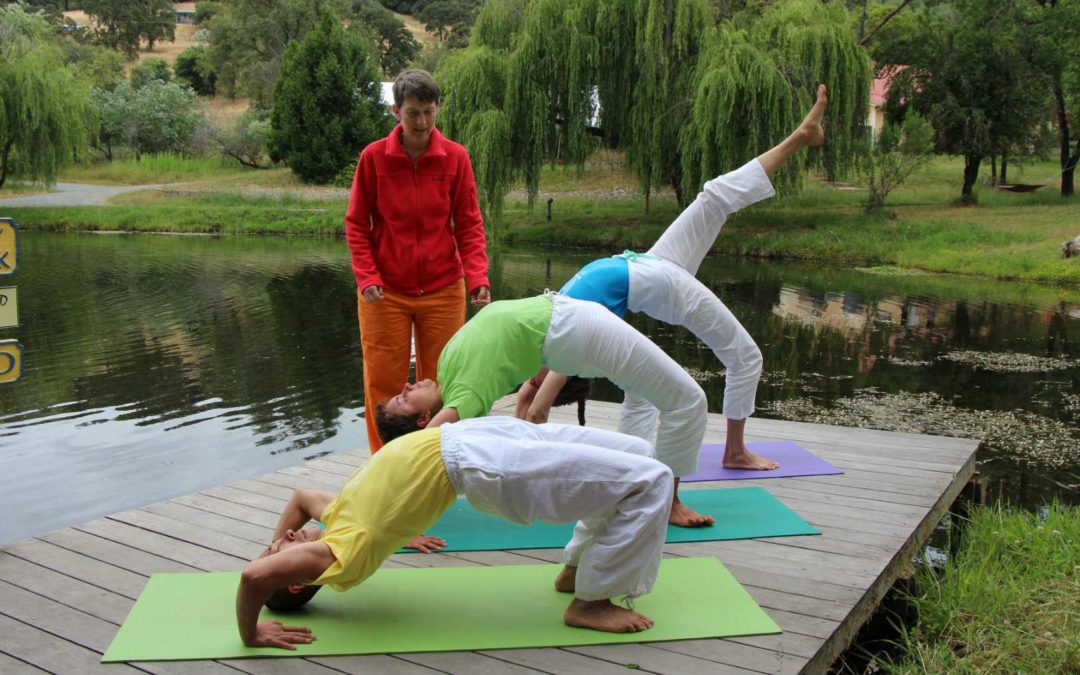by Swami Sitaramananda | Oct 20, 2014 | Uncategorized
So the topic we mentioned this morning, we start to explore this topic this weekend about Holistic Yoga and what that means, ok? So we mentioned about that the equivalent of Holistic Medicine This word I hear from a Dr. the MD of Doctors who is using Yoga for Yoga Therapy and I like this word, because I thought for a long time of words that represent what we are teaching. In our yoga guidelines you would see that they use the words classical yoga or Sivananda yoga to describe us. The words Sivananda Yoga has been used a lot, and we identify ourself to be Sivananda Yoga and it will refer to, and there is still discussion on the level of the board of directors, last time I was there, about this term (Sivananda Yoga) because in our Yoga Farm brochure I describe what is Sivananda Yoga and I brought the brochure and we discuss: is there such a thing called Sivananda Yoga? So the opinion back and forth they say, yeah, we teach yoga, the argument is that we teach yoga, not just Sivananda Yoga. Sivananda is a teacher, that’s all; yoga is yoga, yoga is thousands of years old. But then, it is true that in our world here, we identify ourselves with a name and everyone is teaching yoga, so it gets confusing. So the end of the discussion they agreed to use Sivananda Yoga, if need be. So, that’s it, the brochure is accepted.
The idea is, living here and working here for a long time, in North America, and there is so many different yoga groups, Swami Vishnudevananji kept to a very core teaching of yoga, the essence is the same the way how he formatted and packaged it and offered it to the world of today is different and things are moving very quick, you know the world is moving very quick so we would need to some how adapt. When Swami Vishnu was here there was no such thing as Ayurveda, it didn’t exist. The science of medicine of India, which is a sister science to yoga didn’t exist, in America. And now it is more known, and more and more in depth into society but is still very marginal. Jyotish, a vedic science, doesn’t exist at all. I think I was present in the first meeting of the American College of Vedic Astrology and that was when I was still in San Francisco, which means it must have been around eighteen years ago. So things have changed quite a lot. Now we go through the eps and the flows and the ups and the downs like the old the new, the old culture coming to a new culture, you know the resistance has to mix with the present culture here and how it is able to absorb it or distort it, only a superficial level of it and how more and more people go to the source and you know with the global market everyone is moving east to west, west to east, mixing, we have become a global culture and everything is changing quick.
So this organization is very practical, Swamiji’s nature is very practical, he is more of a doer than a talker, even though he talked a lot. Really he just wanted to do things. He taught theory but he wanted us to practice more, he didn’t want us to waste time because the world needs us and there is no point to sit there and talk. So this organization reflects his character in a sense that all his disciples that you can see, just by looking you can deduce what is going on. This morning I said there are 51 teacher training courses a year, I mean that is a lot of courses, five courses going on at the same time per month. So that is going on. And out of the options of his energy, the training of his disciples and how he predicted it before he left. So Swamiji is into this, in that we keep doing this, get the word out, get the word out, and in itself it is sufficient, just serve, serve, serve, serve and that’s it. I would say myself; the bulk of my learning is from the practice. It is not too much from reading, I don’t have time to read, a few minutes here there, before I go to bed, I’m too tired, its too late so I don’t really read. I read in heaven, that means, you know, I think about it when the mind is so completely immersed in it that you are constantly thinking about it, you see, so intuition and so on operate, a lot of the bulk of my knowledge come like that; and I just sit meditation or something and you know, in front of the pictures of the gurus and everything just comes. So that’s the way how it works. Now why I am saying this is to come back to the idea that what are we teaching, Sivananda Yoga, the word now has been accepted defacto, the world identifies us as this kind of yoga, we talk about classical yoga no one even knows, we talk about Sivananda Yoga maybe people know more. Integral Yoga is referring to Swami Satchidananda organization, even though Master Sivananda used the words Synthesis of Yoga, nobody in the world would know what Synthesis of Yoga is, if you come out and say I am teaching synthesis of yoga, forget it. So you have to say I am teaching Sivananda Yoga. But the word Sivananda yoga has to imply that it is Swami Vishnudevananji because Swami Sivananda has never been in the West and Swami Sivananda’s teaching came to the West through Swami Vishnudevananji, very much so. Swamiji did not give a different name, like Swami Satchidananda gave a different name Integral yoga and (lists other disciples) the different disciples of swami Sivananda gave different names to their organization, to what they teach, but Swami Vishnu, the most confusing fact of history is, he kept the name Sivananda Yoga, to make the point that it is not him, it is the lineage. But then it gets things complicated for us here because when you say Sivananda Yoga you have tendencies to forget that Swami Vishnu has a very specific approach, it not replaceable, you cannot compare between the different disciples of Swami Sivananda, they teach the same Synthesis of Yoga but when it comes out at the end of the line, what they practice is very different from what Swami Vishu taught, you see that or no? Lets say Swami Chitananda, Divine Life Society, right at the source, teach yoga but the product, what they teach there, the specifics is very different. I know that because I teach in Asia and there are different movements there and different teachings and people, so there is confusion. People are looking for what we are teaching but don’t know what name. This whole thing is complicated because they don’t know if its Swami Vishnudevananji or Divine Life Society, so its all confused. In the West here, because Swamiji’s been here a long time so it’s less confusing, people still know. You can see from directories and so on and magazine articles that people jump way over the head of Swami Vishnu and go to say the Sivananda but they don’t recognize the whole work of the organization and Swami Vishnudevananji did. There is no Sivananda Yoga without Swami Vishnudevananji. So that is the fact of history, we just live with it, just for you to know. Every time when you teach you have to bring out the two names, and the two pictures, that’s the way, and explain to people why, why two? One guru is already complicated enough, guru two is even more complicated. So you have to explain that it is the lineage, and the lineage is beyond the form. It is an essential teaching, the form, but it goes through a lineage, which means there is a clear line of command, a clear connection to the training.
So what does it have to do with us and the topic today? My take on the new situation in North America about yoga teaching and how it has been developing. Even though they say the anniversary of it was ten years ago, of one of the founding meetings, it was again while I was in San Francisco, so maybe 15 years ago, since I have been here fifteen years, of the yoga therapy movement, yoga therapy association. At that time I was one of the people sitting at the founding table. Now they have become bigger, you know, the name of yoga therapy became big and at the conference they have more and more in attendance. And I was at one of those, in LA, and people from India and other places talk about yoga therapy, but truly, its boring for me. I am into yoga for so long and im always researching, but why it is boring is, they want to make yoga therapy become something very scientific, its yoga but using the western motive. To prove things. So for example they go into the details of research because they want to be accepted by the scientific and medial community for prestige and money purposes for insurance purpose, so everything starts to be very scientific and for example to say that yoga is good for asthma, then you have all the research you know how it is good for asthma, Yoga is good for reducing high blood pressure, then we have all the research. So it is good for it, and Swami Vishnu himself, being very scientific minded, he did this kind of research in cananda, he created his own lab and brought in scientists to do the research with. So now there is this yoga therapy movement that is very much going in that direction of being accepted and being scientific and almost to the point of not listening to the spiritual angle, or view, of yoga. Which is very much what we are teaching. So, for example, doctor frawley who is a bhramadevastrasti he is one of the most recognized vedic teachers of yoga and ayurveda and jyotish. He is not participating in that movement at all. He is denying it and by denying it. I don’t know how, don’t say it like this officially, but from a conversation with him that’s what I understood. That’s where that stands right now. But people even MD’s that have this holistic views that present how bhakti yoga is important in yoga and how spirit is important than would not be so accepted by the yoga therapy movement, that is what doctor Tim Mcall, who will be teaching a course here I hope you can come, is saying. So that is one side. And then we are teaching this holistic approach of yoga from day one. Swamiji talked, like I said what Ayurveda was not at all existing, or just in a minor way and jyotish did not exist in this country then he taught already the whole thing and the organization never changed, they always teaching the same thing, why because the premise are correct there is nothing to change about it. in the beginning he did not bring out so much of the bhakti, I heard, in the beginning Gajananam was not really mandatory and there was no puja, no priest, no Krishna Temple, Canada was the first one, and so on but then after it became much more promoted, accepted, all ashrams had pujas, priest and so on and so forth. Now with the movement of ayurveda and jyotish this country of the west, America, is taking hold of all these different kind of healings signs and vedic science to help the world more and more. So then the yoga movement itself, besides yoga therapy which is starting to go more scientific, lets say it like this, I am more happy to be myself in the present in a jyotish conference, in an ayurveda conference than in a yoga conference. Something is going very wrong. Systematically throughout the years I have been marketing yoga journal conference, meaning im going not by choice, still now yoga journal when it comes I look through, and if I spend any time looking through this then I start to think, oh my god, im looking at fashion and how fit I am, you know, clothing, yoga mat, this and that it becomes such a fashion thing, very much a materialistic approach to yoga. So the yoga movement lost its spirit and the Sivananda classical and other ___ organizations are doing like us, that means, step back and be absent on the market place, but you know, people still find us, teachers training courses are still filling up, people find us, somehow without being very present, people hear us and still find us and almost more than 50-60% TTC students, we interview them and ask them why they come, they always say because I looked for genuine yoga, spiritual yoga, I found you, im very happy to find you. Ok? So just to say that you should not, being out in the world, feel bad about your training you should feel very proud of your training, not that we want to be proud, but just to say, it’s a very genuine, authentic, very deep, you should carry on with it and embrace it, the more you embrace it the more you get an incredible treasure from it, so don’t be confused when you are out there. Be discriminative, and the way you look and be discriminative is to always look at your guru and then everything will become clear. Look at the organization and the teachers and everything will become clear, if you start to look out and compare yourself than that is how you become confused because you want to try this style that style mixing up all together and creating your own brand. That is how you dilute the teaching. We are still making a point to not dilute the teaching, so teachers training course sa re still very strict, you know, so that is what we are still trying, and I myself I cannot rest because it is still that going on, I have to be there, so now, how is the yoga, as we have been taught, specifically good for therapy and healing purpose. So we talk about healing purposes.
So here, the three bodies. The question is how the yoga that you teach is helping healing as a yoga therapy in itself. Physical body, Astral body, causal body, all of this we know. You know the physical is made of the gross five elements, the astral body is made of the pranic sheath, prana, maya kosha; why is it called maya? Because it is an illusory sheath that is veiling the reality so that’s why it is saying the reality of maya, the veil that you need to unveil. Physical Body is called the annamaya kosha, the food illusion sheath. Astral is called pranamaya kosha, the veil through the prana, and then you have manumaya kosha, vignyamaya kosha, and then you have the anandamaya kosha, which is in the causal body. A kosha means a veil, a veil of consciousness that don’t allow you to see the true self. So the classical teaching is always about self-realization, nothing else but realization as a goal. So the idea is the spiritual ignorance that makes us believe ourselves to be something else, identifying with the vrittis then we identify with our thinking in the mind and then the thinking becomes solidified and it manifests as the different karma and then the body is born in the physical body in order to work through this solidified karmic tendencies that come from the spiritual ignorance in the first place. And the healing aspect would have to go into the deep root cause of the wrong thinking in the first place so the healing has to happen there, ok? So that is why yoga primarily is focusing on the spiritual progress as the prime goal, the purification yoga, yoga is purification and we focus primarily on the purification process. What that means, purification process? That means you would have to clean out the gross veils, all these maya sheaths, the koshas, you have to clear in out in order for you to see through, the purification. There are different ways how you do it, you purify the physical body and identification with the gross physical body how? This is the most important point, if you identify yourself with the physical body than the problems come. The moment you think I am this physical body at that time all the problems come because you situate yourself the wrong way. The physical body is your instrument, if you think you are the physical body then that is the beginning of a big problem. So you purify it through asanas and the practice of proper diet. Because if you eat a proper diet then your body will function proper and will not be a hindrance, if you are not cleansing the physical body proper than the body becomes a hindrance, something that you will see all the time. The pranamaya kosha, how do you purify it? By pranayama, ok? The manumaya kosha how do you purify it? Manumaya is the mind, emotions or the senses, and in it you also have the subconscious, so how do you purify the manumaya kosha? You can say meditation of course, but meditation is at the end of it, what is it? Positive thinking, yamas, niyamas, proper behavior, the karma yoga, bhakti yoga—bhakti yoga sublimates the emotions and manumaya kosha contains the emotions, the subconscious is in there. Ok? And of couse the practice on concentration and meditation, all these mental raja yoga practices are in there. Vijnanamaya kosha, how do you purify it? Definitely through self inquiry, jnana yoga techniques, meditation and also karma yoga why? Because vigjnanamaya kosha has the intellect but with intellect also the ego. So how do you purify the ego? Karma yoga, you need to get the selfishness out of the way. Selflessness you have to practice. So you have the karma yoga, the self inquiry, the course meditation, ok? Because meditation will show you that the intellect is limited, the only way how you know the intellect is limited is when you have the experience of something that you cannot reason about and yet the experience of intuition that you know and yet cannot reason and do not know how to demonstrate it. you see? And yet you know and what you know is correct, and that is why the scientific approach is limited, why? Because it disregards that other, higher, faculty of the mind which is a super conscious, the intuition aspect. So, the causal, anandamaya kosha, how do you transcend it? Samadhi. Why? It is not just only a light meditation that can do it, because meditation already leads you to anandamaya kosha but your still being veiled. So you have to have the experience of Samadhi, complete absorption of the mind, only at that time do you know that the reality is more than the anandamaya kosha, go beyond that kosha. So by the experience of deep absorption go to Samadhi. So you can see that from this, that what we are already teaching here is the four paths of yoga, we are teaching raja yoga, hatha yoga, and hatha yoga, raja yoga are part of what is called the 8 limbs yoga, ashtanga yoga. Classical ashtanga yoga, not the modern ashtanga yoga. The classical ashtanga yoga is all based on the yamas, niyamas as foundation. Without the yamas and niyamas as foundation you cannot build up the other rungs. That means again you have the yamas niyamas and all the practices of ahimsa and with that already what we say the yogic lifestyle is filled with it, you have the practice of ahimsa, practice of sattva, so the sincerity, honesty, truthfulness is there, you have the practice of bramacharia, the control of sex and sensual drive. You have the practice of nonstealing, you have the practice of nonaccumulation. That means the yogi has to live a simple life. And then you have the yama, niyama you have the practice of purity, purification, you have the practice of tapas, you have the practice of contentment, the practice of austerity, contentment. And then you have the practice of swadhyaya, self study, the practice of spiritual study, how do you do that? You have to read scripture, you have to listen to teachers, you have to be in satsanga, and you have to remember, remember as much as possible who you are, who your true self is, and then the last you would have to do self-surrender. You can see all this is part of the integral part of our teaching, is it not? When you are being trained in TTC what do you have to do? You have to do Self Surrender. Is it not the prime thing? If you don’t do it, if you don’t follow, you don’t do whatever you are supposed to do, your out—you will not be kept in the class. Yes or no? So that’s the prime thing, the practice of self-surrender: the satsanga everyday, the practice everyday, very very tedious practices. So all this are there, we teach the yamas, niyamas, we practice yamas, niyamas, we teach the 8 limbs of yoga, we teach also bhakti yoga, we teach karma yoga, karma yoga is the prime thing; the teacher is supposed to be karma yogis and serve. If you are not karma yogis and you do not have that ideal service and you did not bite into that ideal, the sivananda teaching of the four paths of yoga, I don’t think you would be here. You know? I don’t think you would survive the test of time. And then, what else are we teaching? Swamiji put it in a very simple form, proper exercise, asanas, proper breathing is pranayam, proper diet is the lifestyle, and food is so important because food creates the mind; and then you have proper relaxation, which is part of that philosophical self-surrendering attitude. The relaxation is also the non-doership, ok? That will bring about the relaxation, the detachment that brings about relaxation. Swamiji so genuinely did not say all these complicated words, he just said proper relaxation, so everyone would say, “Ya I want to relax,” you see? But really, in the relaxation you have right there the jnana yoga, its right there, the detachment is right there, the non-doership is right there. And then the last is positive thinking and meditation, which is raja yoga and jnana yoga. It’s there. So by teaching the 5 points and the 4 paths, and do it yourself, and connect with the guru, and being in satsanga, doing it as a selfless service and be humble, you are doing it. You are becoming the instrument of the teaching.
Now, what Ayurveda has to do with this? Ayurveda has its own, it’s based on the Vedas so it has the same kind of premises. That means, ignorance, spiritual ignorance is the cause of disease, ok? Misuse of the senses is a cause of disease, misuse of the intellect is a cause of disease, and the speeding up, they say the three causes of disease, the speeding up of the mind. What does that mean? The more your mind is rajasic and tamasic the more you churn, you know? The more you get old and die early. The more you are calm, quiet and dwelling on yourself and being peaceful, knowing yourself, don’t get yourself too upset, too uptight about things, they detach about things, the more you slow down the process of disease. Ayurveda is based on the theory of the five elements and the three doshas, doshas are the faults, imperfections, that means, the three distortions, your constitutions. The main distortions. You will be healthy if you live according to your constitutional dosha, in the beginning at your birth and if you can go back to that then you will be healthy, and it is said that through the facts of life and how you react and how you change your thoughts are and how you react to a common situation then you develop a different other kind of vicruti or different kind of constitution, change. So by using these two factors, the original, you know, constitution, and your present constitution, and change how to regulate and bring it back to the constitution that you are having now and the original constitution, by regulating this you bring about a certain state of health, ok? So what is it, you would have to work out your karma in yogic terms it says you would have to work out your karma to be healthy; because when you are born you have the karma with the physical body, and through the process of working it out, you would have to come back to that original reason why you were born. That tendency, but with the awareness so that this time you may be healthy. So ayurveda is very much of a different practice of herbs and nutrition that are important and cleansing and mental process and so on in order for you to get you back to that state of calmness, in a way, that state of health, that is the job of ayurveda. SO if you can see through that, you can see that Swamiji, even though he put his five points, elements, and remember Swami Sivananda was a doctor and Swamiji was very health conscious, being his disciple, the disciple embraces the guru’s thinking, that is called a disciple. It is very much of a health concern, you see. They say, health is wealth, peace of mind is happiness, yoga shows the way, so we teach two things, health and peace of mind. It is in the five points that you receive that you have the health. The health premises for the teaching, you already teach health just by teaching the five points, very simple, don’t have to talk about anything too much, don’t have to talk about chakras, transcendental things, don’t have to do anything very complicated, just make people do their asanas the proper way, because the sequence of the asanas, the way how you have been taught, the five points, and the philosophy are already imbedded in it, if you think about it, its very, very smart. So the whole thing of the combination between the effort of a raja yogi and the self surrender of a Bhakti yogi, the focus, enquiring and the detachment, all this are there already in the yoga class, when you are going through the different movements and then you have to relax is part of it and the sequence of it, why you do the headstand first, its already the spiritual base of that, it is already there, the whole idea that we are primarily consciousness and everything that we do comes after. So primarily you put your head proper, you work with your highest chakra, that means you bring your consciousness correct and then everything else falls into place. All the other subsequent postures in the sequence of the posture fall in place. That means you end up in a standing posture, balancing posture, standing posture -balancing posture for what reason? You stand on the feet, on the ground, and you balance with the world; you balance with the elements. Your rooted at your feet, so this is at the end of the yoga session, the first posture is the headstand, it is not a standing posture—that means the philosophy is already behind. First get your spisitu at the right plkace and then aafter that compose with the world, then you can be a person balancing in this world. How you can balance? You can be very centered in the posture, in the tree posture, you can just look and be centered and you are not loosing balance. It was just an ideal of the yogi, an ideal of jnana yogi, is be in the world out of the world using balance, equanimity, see? Its already built into the sequence of the teaching, ok? That looks so simple that you might think that it isn’t teaching anything, you know? But its not. So follow the sequence of the class you have learned.
Now there is a new book that just came out and I had it here, but Ill show you tomorrow, its not here—its in the closet (goes and gets the book). So this is the new yoga book, and as a yoga teacher I would give you a 50% price, it is costly, so you can now have it. It is called Yoga: Your Home Practice Companion, it is by the organization but produced in Europe. I think it is the best Yoga book that exists on the market, literally. So the organization already produced very good books, like Sivananda Companion, the simple yoga: Mind Body, is very good. Yoga Beginniners is very good, Sivananda Companion to Yoga is beautiful, very good. This one excels, it adds on to the knowledge from the past because it gives you the core backbone of the sequences but then it gives you also some anatomical explanation and it gives you the variations, the series of variations. The wrong thinking that we heard is that Sivananda Yoga always teaches the 12 basic postures, its so wrong, so wrong, its so wrong. Its wrong because these are not just postures, these are fundamentals—but out of this fundamental, if you do not go to the fundamental then there is nothing you can build on. Go through the fundamentals and out of that you can build on quite a lot. So it doesn’t give you persay this posture or that posture, it gives you the intelligence behind the posture that you learn, you understand that the intelligence behind the sequence and you understand the fundamentals of it then you can build up the variations of it, you see? So its very ___ system. So you will see in here (the book), also different variations, and it is still based on the 5 points which is one of my points, it is not as much about philosophy, it is still just postures. So it is still fit to our new yoga world and for those who do not know. So this is another book that I would recommend you have, as a teacher (she holds up the Essential book of Yoga). It will compliment your teaching because it gives you the basic kind of philosophy, not for you but for your students, on what we really teach. We teach Bhakti yoga, we teach philosophy we teach not just only the five points, we teach the four paths. So for the majority of people then it is good because, you know, just by doing this, the five points, you get to open yourself, your mind becomes balanced, your prana starts to move, energy balanced, your mind clear, and you start to ask fundamental questions about yourself. It is a therapy in itself because it realigns you with your purpose and aligns you with your own Self. Just by that fact you become spiritually healthy, mentally, emotionally healthy, less aggravated by things, more dwelling on yourself and become more detached about things, and you know your purpose, and you become harmonious with your body, your senses, your whole organs of action, hands, feet, you know your body and your mind, the mind and all its different layers, it has a certain unity, harmony, integration, and out of that you become healthy. So the way this book came was this, at one time there was a group of Chinese people from Taiwon, about 60 people that came here, and wanted to stay here for a week to learn yoga. So I thought, I only have one week to teach everything, so that is how we teach everything in one week. And then, because they are Chinese, we had to translate, and translate in written text so the translator would have something to base from to translate so it come out with an already written text out of that week. So I spent one week, and I take this text together, and I put it out and it became a book. So why is it good—Because it was geared toward a beginner. It was geared toward beginners and so that is why it is so simple. Without ego, I say that it is good for new people, the beginners. So get that, we produce it here so we can give you discount, as a teacher you buy in quantity to distribute and we will try to see if we can even publish it further. It has bee approved by the certificate board, after they found a copy in Japan.
We are teaching this five points, four paths, and as much as possible, linking also with the idea of self healing in Ayurveda, even though Ayurveda has its own language, you know, and its own theory, its own language its own theory. But it helps for yogis to know a little bit. What is the way, how you can help a person that is completely out of balance. When you see a person that is completely red from beginning to top, you say something is wrong with your pitta. You have to say that and you have to somehow not aggrevate them and calm them down. Or when you see a person that is so Kapha, then you know you approach them differently, and a vatta—you know you have to be able to know. So vatta, kapha is very simple. The ayurvedic diet is simple, you have to learn the basics, add on to the yogic diet, we don’t teach an ayurvedic diet persay, we teach a yogic diet—what is the difference? A yogic diet is a sattvic diet, because the idea of yoga is sattva will bring about the capacity to review the Self. So the prime thing about yogic diet is sattva. Okay? The main thing in Ayurveda is about health, so ayurveda can prescribe things that yoga would not, okay? That is the difference between Ayurveda and yoga. Ayurveda is for healing and yoga is for healing of the spirit. You understand? Healing of the spirit means recovering your true self. And from there everything else will fall in place. You go much deeper to the level of the primordial self, what we call the Atman; so it differs, Ayurveda and Yoga, even though it has the same premises its method is different. Get that?
So then the last thing is what does Jyotish have to do with this? For some of you it might be completely new, those who are aspirants at the Ashram, who have been here, are not so new because we have been teaching it for a long time, last labor day we had the eleventh year conference here and now we are becoming one of the institutions that teach vedic astrology in north America. There are many. And next year we will be doing the exam to become vedic astrologers here. So it can build up more if more people are going to participate, for me it is very clear in my mind, without a doubt, I have never be doubting, that yoga is what I do, it is what I like to do, and jyotish and ayurveda are only a means for me to help. Yoga is the prime thing, the liberation, the understanding of the Self, all the method to remove the veils is what we do. And then here, health and healing is the prime thing; healing of the spirit and then help also people to go through the things. I also myself have ayurvedic diet, ayurvedic consultations, so on and so forth. It is to help the body, but it is not my prime goal, if there is a contradiction between choices, then I always choose the yogic choice. If the Ayurvedic practitioner said I need to eat meats then I say no, I don’t eat meat. I can die, but I do not eat meat. So that is the choice that you make.
And then jyotish is also a means. SO I am going to show you a little bit about jyotish, you don’t have to write any of this. As the same in Ayurveda you have the three constitutions, and that indicates your instrumentation in this life, and how consciousness is being distorted, by the karma that comes out of the physical and ___that comes with it. In the same manner, you are born and you have the nine planets, or seven, the first two Raju and Ketu, they are both nodes of the moon, it is considered to be two. So the nine planets are the ascenders of Lord Vishnu to deliver your Karma. So they would be there in your birth chart, and there it would come out the different circumferences of your life. It can show your basic constitution, it shows your karma with family, with your own body, your health and your destiny, it shows also your relationship with family, money, brother and sisters, and with your communication with your heart, with your mother, and your teachers, your education, and with your enemies, with your partner, with your psychic, with your religion, your guru, your teacher, your virtues, or vices , your work, your profession ,your contribution in this world, your community, your gain, the ways how you are going to remove your ego or accumulate more. All these are written in there, okay? And which way it helps your students, it will indicate the karma, it helps you appreciate and indicate the karma of your own and others so that you learn your strengths and weaknesses, the tendencies of your mind, and your faults. And how you are going to balance it out through yogic sadhana. So it will help for you to, if you don’t know, lets say your vatta, pitta, kapha and you do the 12 postures, the pranayams, the meditaion and you are living the yogic lifestyle, the diet, it is balanced out anyway your vatta, pitta, kapha. Even if you don’t know if you are Jupiter or Mercury or Mars, which one is predominate in your chart and where is your Raju and where is your Ketu, what is your, you know your, main planet and what aspects it and what contradicts it and whose enemies you are living with, it doesn’t matter, you practice the five points, four paths, it balances out anyways. Your Karma will be alleviated by itself. So that being said it doesn’t mean you have to study ayurveda, or you have to study jyotish, you just teach whatever you are teaching and it will help people and help you. If you want to have more tools then you can learn a little bit more so you have more language, keep them separate things and help the awareness, that’s all. So that is yoga and the vedic sciences that is complementary, now (I want you to erase and draw the chakra man), 1:09:41
The man is too long, that’s why. So now you going to draw the chakra. And then you’re going to give a little illumination to this chakra. Especially asha chakra. Little lights that come out there. A lot of energy. Not hair. Just draw a square. Now, in this square, you draw a triangle going down.
So, when we make this diagram, it’s to guide our thoughts to give us the evolution of consciousness. So, when we talk about yoga, we talk about evolution of consciousness. What does that mean?
When we talk about evolution, that means the level that you realize the truth.
The level that you function out of the truth and the level that the light within can shine through. The level of purification, in other words. Yes or no? Yes. So, these are represented by the chakras of the levels of consciousness. So, in the normal teaching, to beginners, we don’t talk about chakras. They say, focus on your manipura chakra and see the red light, or something like that. None. It is forbidden. It’s a strong word to say that. You don’t confuse people. Chakra, you have to have spiritual awareness for each chakra. So, what we’re teaching about is primarily purification practices. Just by teaching purification practices, and people are able to follow in a long period of time. So, that is the mark of a good teacher, to be able to carry people from stage one, two, three and for a long time. The teacher has to be selfless. They have to be there. So, people have to be purified at some level for them to understand what is the evolution of consciousness. So, for now, for them to go through the pain, because they come to you with pain and suffering. And pain and suffering, primarily because of spiritual ignorance. But you can say to them..They come to you. They’re stressed in their life. They just lost their job, their money, their wife quit them. So, you can say, it’s your spiritual ignorance that creates the problem. You see, it doesn’t help. So, you would have to help people to teach the five points and they calm down, do positive thinking. Positive thinking is very important because the wrong thinking is the root cause of the karma. Learning to accept the life condition and work with people’s wrong thinking, you help people a lot. So, basically, when people are still in that phase of consciousness, the base one, muladana chakra, then at that time they are still spirit, but they are down, because they identify themselves very strongly with the physical and with that they have no clue how to integrate the different feelings they have, the different conflicts they have inside, and they don’t know where they are at. They don’t know what the level of evolution is, who are they, they have no idea. So, from there, a lot of suffering comes. So, this base chakra is where all this happens. All the problems of sensual problems, emotional problems, sexual problems, mental problems. The confusion that comes from not knowing what to do in life. The conflicting with spirituality and non-spirituality. Sometimes, the huge conflicts that can sometimes put them in mental institutions. So, all terrible suffering. Addiction, people going into crime, abuse, self-deprecation, all the problems are there.
When you are helping people holistically, teaching the classical yoga, all the implications and all the branches basically passing that level. When you bring some light there, then, if the teacher is without evil, then eventually the person would be able to recognize…
So, basically, the problem that you’re dealing with, the first and the second, just below the navel is the low-mind stuff, instincts, emotions, contradictions. All this is happening when you are still subject to your karma. So, people come to you. They don’t have awareness. They feel they are subjected to karma. They feel they cannot change their life. They are a victim of things. That’s when the problem happens. So, your job as a yoga teacher is to empower them back to their sense of self and empower them that you can change your life. Your problems come because of this and that and yes, the problems come from within and you can solve the problems from within and you can do this and you can do that. And you might not formalize exactly what is the problem. It takes a lot of skill if you’re able to know exactly what is the problem. It’s something you cannot be trained to do, it takes a lot of skill and time. But, what you say do is if you do this practice you can say with confidence, you do the pranayama, you do your asanas every day, I can guarantee to you that your problems will be solved. You’ll be much better. Believe me, you can say that with confidence. You see. Because all the different layers of the body would become somehow integrated, cleared out, the prana will flow automatically one-hundred percent. If the person is too crazy and is not able to do asanas and do simple asanas, breathing, simple relaxation, there is a holistic approach that still can help. I would not say to a person to go take pills or medicine. That is making them a little more dependent and it has a side effect. I would not advise that in due conscience as a yogi. And very rarely in my life maybe have I referred people to therapists. I don’t even do that. I believe in yoga therapy. I believe in yoga psychology. But, I do refer people to a yoga practitioner and psychologist to understand more. But not a normal psychologist. Not medicine. But, in general, if you can teach people these classes, pranayama, diet and listen to them with compassion and positive thinking technique, helping them to calm down, you already did a great job. Then, it’s a very big help that you do. Ok? No doubt about that. And then, as for yourself, you need to gain more control over your life as a yoga practitioner. You try to transcend and overcome your own lower mind and then try to become a little bit more mastering of your own will and your own destiny and at that time you would improve, increase in consciousness. This would happen automatically and then the insides, the wisdom comes to you automatically. If you have a real problem in your life, know that it’s not something that’s not relating to your sarana(?). Because Sarana that you do implies change and transformation. You cannot do sarana and your life is always the same. It’s not possible. Your life will change. You will transform and you will be able to acknowledge this transformation by knowing the pulse of it, if not you get the teacher to help you to know what is the pulse of it, then you’ll be able to more confidently walk on this path with less confusion. Ok? That’s it. Any questions? No.
By Swami Sitaramananda
West Coast Teachers Meeting, Yoga Farm, 2010
© Swami Sitaramananda 2014 No part of this article may be reproduced in any form without the written permission of the author.
